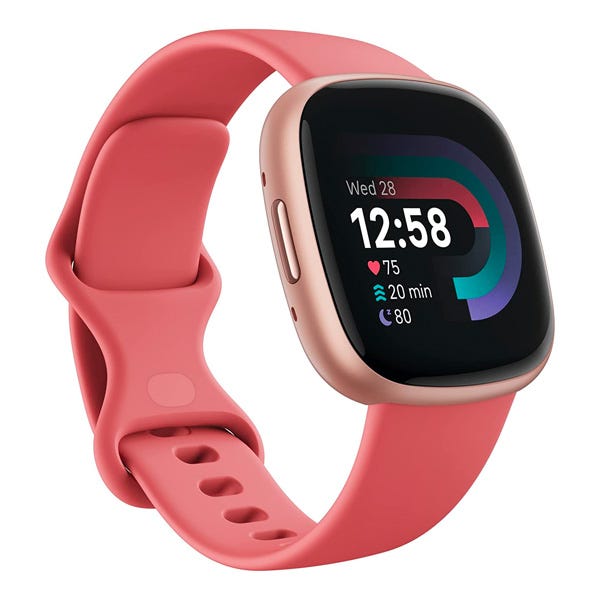When you buy through our links, Insider may earn an affiliate commission. Learn more.
Fitbit’s Versa line of wearables remains some of the best fitness trackers on the market. With GPS functionality, Bluetooth connectivity, and compatibility with Google Assistant and Amazon Alexa, anyone can benefit from their usefulness and versatility.
The most current version is the Versa 4, a smartwatch we ultimately found to be a disappointing next step, and one that’s hardly an upgrade over the previous generation Versa 3. Although we’ve covered the Versa 3 and Versa 4 extensively in our hands-on reviews, below is an in-depth look at how they compare.
The bottom line is this: The Versa 4 doesn’t change enough about the Versa 3 to justify its higher price point. Because Fitbit stopped selling the Versa 3, you may even consider a refurbished model of the device instead of upgrading to the Versa 4. Here’s why.

Fitbit Versa 4 vs. Fitbit Versa 3: Design
One of the reasons it’s hard to recommend the Versa 4 over the Versa 3 is they’re virtually identical. The only discernible hardware difference is the inclusion of a button on the left-hand side of the Versa 4. Pushing this button twice prompts Amazon’s Alexa assistant; holding it down displays a handful of stats from the day’s workout.
If you’re new to Fitbit, this feature probably won’t make any difference. Longtime Versa wearers will recognize it’s actually a reversal of Fitbit’s trend of cutting down on physical buttons with each iteration of the series. If nothing else, it serves as a metaphor for Fitbit’s approach to the Versa line of introducing an odd and unnecessary feature in the name of “newness.”
The Versa 3 had no buttons, mostly because it didn’t need any; Alexa and Google Assistant still had complete functionality, and everything like fitness data, trackable activities, and its various apps were still easily accessible. That makes the inclusion of the button — the only tangible change made — an entirely aesthetic one.
All other physical aspects of the Versa 4 remain the same as the Versa 3’s, from its 1.58-inch AMOLED screen to the touch controls for navigation. One could argue this is a classic case of, “If it ain’t broke, don’t fix it.” But since the Versa 4 doesn’t really add anything that new, we’re left wondering what the price jump is for.
(Pro tip: It’s the button. You’re paying $50 to $100 more for the button.)
Fitbit Versa 4 vs. Fitbit Versa 3: Smartwatch performance
One of our biggest gripes about the Fitbit Versa 4 is its lack of support for third-party apps. Many of the features that made the Versa 3 one of the best Fitbits, and one of our favorite entry-level smartwatches, are no longer available.
While development tools still exist for anyone with a bit of coding ability and patience, Fitbit discontinued support for third-party apps on both the Versa 4 and Sense 2, meaning that most people are stuck with whatever comes out of the box for these devices.
Many third-party apps are still listed on Fitbit’s website, meaning they should be available to download to the Versa 3 and other models. These include Spotify, Maps, and accounts for various stores like Starbucks and Walgreens.
Fitbit Versa 4 vs. Fitbit Versa 3: Health and fitness tracking
Tracking features are roughly identical for the Versa 3 and 4, which means there isn’t much of an upgrade. Both devices offer metrics for blood oxygen levels, sleep tracking, heart rate monitoring, and compatibility with a wide range of exercises like trail running, snowboarding, and cycling.
There is one major thing to consider, though: We ran into significantly more issues with the built-in GPS while using the Versa 4 to track activities like runs and bike rides. Oftentimes, the device struggled to sync to GPS and even fell short in estimating distance readings during those lapses. For those looking for a reliable fitness tracker, we can’t recommend the Versa 4 to fill that need.
And while the Versa 4 does a decent job tracking the other things listed above, the fact the Versa 3 is a better activity tracker and offers accurate health tracking makes it the favorite in this category. It’s a far more accurate watch that costs upward of $100 less.
Fitbit Versa 4 vs. Fitbit Versa 3: Battery life
Finally, the Versa 4 can boast one advancement: The battery life is markedly better than the Versa 3’s. However, this should be expected of any generational step forward for any device.
The Versa 4, according to our tests, lasts around six days depending on GPS usage. The Versa 3 maxed out at approximately five days of use with heart rate monitoring, sleep tracking, and exercise recording throughout. Additionally, this required the always-on display feature to be, well, always off.
But it’s unclear what that extra day of battery life actually buys you, considering the stunted functionality of the Versa 4. More time on a less-usable device isn’t necessarily an improvement.
And considering how fast the Versa 4 charges, it’s especially disappointing how little the device does. In our full review, we found you can get a whole day’s use from just 12 minutes of charge time, which would be a massive achievement for any other device. But most people won’t be using sleep tracking, exercise routines, or GPS for all 24 hours of the day, and the Versa 4 offers little else to fill that time with.
Which should you buy?
Fitbit no longer sells the Versa 3 on its website but the device is still available from third-party retailers like Amazon. It may be more difficult to find as time goes on, but its lower price tag and nearly identical (perhaps even superior) functionality to the Versa 4 makes the Versa 3 the clear winner in a head-to-head matchup.
However, if you’re a Fitbit enthusiast who hasn’t had the chance to use a Versa, either option should provide a solid experience if you’re in it purely for the metrics.
Remember that both devices have severe downsides that will only get more cumbersome in the long run. For the Versa 3, it’s the discontinuation of the device itself and the lack of overall official and community support that comes with that.
For the Versa 4, it’s the company’s decision to abandon third-party apps, severely limiting the growth of the ecosystem these devices rely on. Not to mention the fact it’s a subpar activity tracker. It is a Fitbit, after all, so that’s extremely disappointing.
If you’re interested in a device that has more long-term support, we’d recommend taking a look at our guide on the best Fitbit, which includes other models like the Charge or Inspire. You should also consider other fitness tracking brands that are often worth the higher cost for their durability and functionality: these include the best Apple Watches, our picks of the best running watch, and the best Android smartwatches.


Read the full article here





